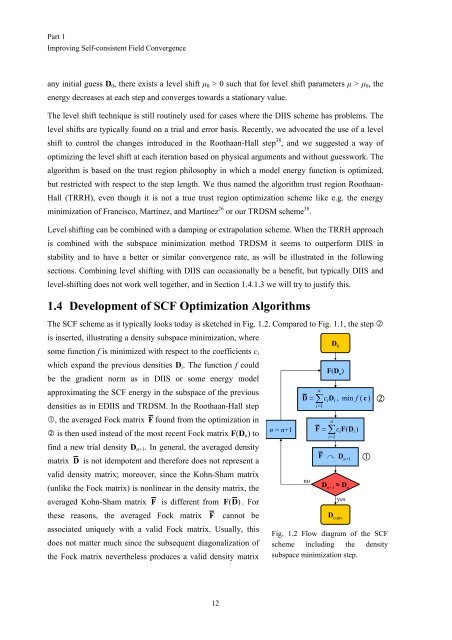Get my PhD Thesis
Get my PhD Thesis
Get my PhD Thesis
Create successful ePaper yourself
Turn your PDF publications into a flip-book with our unique Google optimized e-Paper software.
Part 1<br />
Improving Self-consistent Field Convergence<br />
any initial guess D 0 , there exists a level shift µ 0 > 0 such that for level shift parameters µ > µ 0 , the<br />
energy decreases at each step and converges towards a stationary value.<br />
The level shift technique is still routinely used for cases where the DIIS scheme has problems. The<br />
level shifts are typically found on a trial and error basis. Recently, we advocated the use of a level<br />
shift to control the changes introduced in the Roothaan-Hall step 38 , and we suggested a way of<br />
optimizing the level shift at each iteration based on physical arguments and without guesswork. The<br />
algorithm is based on the trust region philosophy in which a model energy function is optimized,<br />
but restricted with respect to the step length. We thus named the algorithm trust region Roothaan-<br />
Hall (TRRH), even though it is not a true trust region optimization scheme like e.g. the energy<br />
minimization of Francisco, Martínez, and Martínez 26 or our TRDSM scheme 38 .<br />
Level shifting can be combined with a damping or extrapolation scheme. When the TRRH approach<br />
is combined with the subspace minimization method TRDSM it seems to outperform DIIS in<br />
stability and to have a better or similar convergence rate, as will be illustrated in the following<br />
sections. Combining level shifting with DIIS can occasionally be a benefit, but typically DIIS and<br />
level-shifting does not work well together, and in Section 1.4.1.3 we will try to justify this.<br />
1.4 Development of SCF Optimization Algorithms<br />
The SCF scheme as it typically looks today is sketched in Fig. 1.2. Compared to Fig. 1.1, the step <br />
is inserted, illustrating a density subspace minimization, where<br />
some function f is minimized with respect to the coefficients c i<br />
which expand the previous densities D i . The function f could<br />
be the gradient norm as in DIIS or some energy model<br />
D 0<br />
F(D n<br />
)<br />
n<br />
approximating the SCF energy in the subspace of the previous<br />
D = ∑ciDi,minf<br />
( c)<br />
densities as in EDIIS and TRDSM. In the Roothaan-Hall step<br />
i=<br />
1<br />
<br />
, the averaged Fock matrix F found from the optimization in<br />
n<br />
n = n+1 F =<br />
is then used instead of the most recent Fock matrix F(D n ) to<br />
∑ciF( Di)<br />
i=<br />
1<br />
find a new trial density D n+1 . In general, the averaged density<br />
matrix D is not idempotent and therefore does not represent a<br />
valid density matrix; moreover, since the Kohn-Sham matrix<br />
F D n+1 <br />
(unlike the Fock matrix) is nonlinear in the density matrix, the<br />
averaged Kohn-Sham matrix F is different from FD. ( ) For<br />
these reasons, the averaged Fock matrix F cannot be<br />
no<br />
D n+1<br />
≈ D n<br />
yes<br />
D conv<br />
associated uniquely with a valid Fock matrix. Usually, this<br />
Fig. 1.2 Flow diagram of the SCF<br />
does not matter much since the subsequent diagonalization of scheme including the density<br />
the Fock matrix nevertheless produces a valid density matrix subspace minimization step.<br />
12

















